|
|
|
Sort Order |
|
|
|
Items / Page
|
|
|
|
|
|
|
| Srl | Item |
| 1 |
ID:
099206
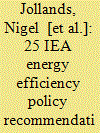

|
|
|
|
|
| Publication |
2010.
|
| Summary/Abstract |
The imperative to pursue energy efficiency improvements is clearly on the political agenda at all levels of governments. This paper explores the lessons from past attempts at galvanising international efforts to expand energy efficiency activities through the use of international-level recommendations. Drawing on these lessons, the paper outlines the IEA response to the call for policy advice on energy efficiency through the G8 Gleneagles Plan of Action. Specifically, the paper outlines a 'necessary conditions' framework that was used to develop a set of energy efficiency policy priorities and describes the subsequent recommendations presented to the G8 in Hokkaido-Toyako Summit in 2008. The recommendations cover 25 fields of action in seven priority areas: buildings, appliances, lighting, transport, industry, energy utilities and cross-sectoral issues. Together, the suite of recommendations sets out an ambitious road map for global energy efficiency improvement. If implemented globally without delay, they could save around 8.2 GtCO2/yr or 96 EJ/yr by 2030. This is equivalent to roughly twice the current total EU energy-related CO2 emissions.
|
|
|
|
|
|
|
|
|
|
|
|
|
|
|
|
| 2 |
ID:
099359


|
|
|
|
|
| Publication |
2010.
|
| Summary/Abstract |
International mandates for smart metering are enabling variable and real-time pricing regimes such as dynamic peak pricing (DPP), which charges 10-40 times the off-peak rate for electricity during short periods. This regime aims to reduce peak electricity demand (predominantly due to increase in residential air-conditioning usage) and curb greenhouse gas emissions. Although trials indicate that DPP can achieve significant demand reductions, particularly in summer, little is known about how or why households change their cooling practices in response to this strategy. This paper discusses the outcomes of a small qualitative study assessing the impact of a DPP trial on household cooling practices in the Australian state of New South Wales. The study challenges common assumptions about the necessity of air-conditioning and impact of price signals. It finds that DPP engages households as co-managers of their cooling practices through a series of notification signals (SMS, phone, in-home display, email, etc.). Further, by linking the price signal to air-conditioning, some householders consider this practice discretionary for short periods of time. The paper concludes by warning that policy makers and utilities may serve to legitimise air-conditioning usage and/or negate demand reductions by failing to acknowledge the non-rational dynamics of DPP and household cooling practices.
|
|
|
|
|
|
|
|
|
|
|
|
|
|
|
|
| 3 |
ID:
099274
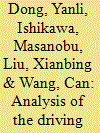

|
|
|
|
|
| Publication |
2010.
|
| Summary/Abstract |
By using the latest China-Japan input-output data sets and the index decomposition analysis (IDA) approach, this article analyzes the driving forces of CO2 emissions embodied in trade between the two countries during 1990-2000. We found that the growth of trade volume had a large influence on the increase of CO2 emissions embodiments in bilateral trade. The dramatic decline in carbon intensity of the Chinese economy is a primary cause in offsetting CO2 emissions exported from China to Japan over 1995-2000. We argue that a better understanding of the factors affecting CO2 emissions embodied in international trade will assist in seeking more effective climate policies with wider participation in the post-Kyoto regime.
|
|
|
|
|
|
|
|
|
|
|
|
|
|
|
|
| 4 |
ID:
099360


|
|
|
|
|
| Publication |
2010.
|
| Summary/Abstract |
This paper provides an assessment of the large-scale implementation of distributed solar photovoltaics in Wisconsin with regard to its interaction with the utility grid, economics of varying levels of high penetration, and displaced emissions. These assessment factors are quantified using simulations with measured hourly solar radiation and weather data from the National Solar Radiation Database as primary inputs. Hourly utility load data for each electric utility in Wisconsin for a complete year were used in combination with the simulated PV output to quantify the impacts of high penetration of distributed PV on the aggregate Wisconsin electric utility load.
As the penetration rate of distributed PV systems increases, both economic and environmental benefits experience diminishing returns. At penetration rates exceeding 15-20% of the aggregate utility load peak, less of the PV-energy is utilized and the contribution of the aggregate electricity generated from PV approaches a practical limit. The limit is not affected by costs, but rather by the time-distribution of available solar radiation and mismatch with the coincidence of aggregate utility electrical loads. The unsubsidized levelized cost of electricity from PV is more than four times greater than the current market price for electricity, based on time-of-use rates, in Wisconsin. At the present time, the investment in solar PV as a cost-effective means to reduce emissions from traditional electricity generation sources is not justified.
|
|
|
|
|
|
|
|
|
|
|
|
|
|
|
|
| 5 |
ID:
099298
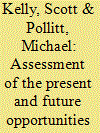

|
|
|
|
|
| Publication |
2010.
|
| Summary/Abstract |
As global fuel reserves are depleted, alternative and more efficient forms of energy generation and delivery will be required. Combined heat and power with district heating (CHP-DH) provides an alternative energy production and delivery mechanism that is less resource intensive, more efficient and provides greater energy security than many popular alternatives. It will be shown that the economic viability of CHP-DH networks depends on several principles, namely (1) the optimisation of engineering and design principles; (2) organisational and regulatory frameworks; (3) financial and economic factors. It was found that in the long term DH is competitive with other energy supply and distribution technologies such as electricity and gas. However, in the short to medium term it is shown that economic risk, regulatory uncertainty and lock-in of existing technology are the most significant barriers to CHP-DH development. This research suggests that under the present regulatory and economic paradigm, the infrastructure required for DH networks remains financially prohibitive; the implementation of government policies are complicated and impose high transaction costs, while engineering solutions are frequently not implemented or economically optimised. If CHP-DH is going to play any part in meeting climate change targets then collaboration between public and private organisations will be required. It is clear from this analysis that strong local government involvement is therefore necessary for the co-ordination, leadership and infrastructural deployment of CHP-DH.
|
|
|
|
|
|
|
|
|
|
|
|
|
|
|
|
| 6 |
ID:
099279


|
|
|
|
|
| Publication |
2010.
|
| Summary/Abstract |
The objective of this study is to assess the environmental effects of implementing petrol rationing and the issuance of fuel smartcards in central Tehran. The results and their application are significant from the perspective of preserving fuel sources and protecting the environment, both of which being among the goals of sustainable development. Through the analysis of soft data (owners of automobile and light pickup trucks attitude), 3 general hypotheses were assessed and the result was compared to hard data (the traffic situation information, petrol consumption and air pollution). The soft data was gathered using a comprehensive questionnaire which randomly distributed among 2000 automobile and pickup truck drivers in the central Tehran area who were at petrol stations to refuel their vehicles. The gathered data was then analyzed at two levels: descriptive and inferential. The results of this research reveal that according to the soft data, the smartcard project has resulted in a decline in traffic and petrol consumption and a rise in air pollution; furthermore, the positive cultural effects of this project have been comparatively prominent. The actual figures show that the project has led to lower traffic load and air pollution but petrol consumption remains the same as before.
|
|
|
|
|
|
|
|
|
|
|
|
|
|
|
|
| 7 |
ID:
099270
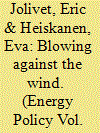

|
|
|
|
|
| Publication |
2010.
|
| Summary/Abstract |
This paper analyses the deployment of wind power and the related local controversies using actor-network theory (ANT). ANT provides conceptual instruments for a fine-tuned analysis of the contingencies that condition a project's success or failure by focusing on the micro-decisions that intertwine the material aspects of the technology, the site where it is implemented, the participation process, and the social relations in which they are embedded. By considering controversies as alternative efforts of competing networks of actors to 'frame' the reality and enroll others, ANT sheds light on the complex and political nature of planning a wind farm project, insofar as it consist in aligning material and human behaviours into a predictable scenario. 'Overflows' occur when actors do not conform to expectations, adopt conflicting positions and develop their own interpretations of the project, thus obliging designers to adapt their frames and change their plans. To demonstrate this framework, we apply it to the case of a wind farm project in the South of France, near Albi. Our analysis suggests a new approach to examining wind power projects in terms of the interaction between globally circulating technologies, unique characteristics of the site, the participation process and the social dynamics that emerge when these are combined.
|
|
|
|
|
|
|
|
|
|
|
|
|
|
|
|
| 8 |
ID:
099352


|
|
|
|
|
| Publication |
2010.
|
| Summary/Abstract |
Over the last three decades, privatization and restructuring of electricity sectors has been a hot topic. The expectation was that prices would fall due to increased competition and that generators would become more innovative and efficient. However, the enthusiasm for deregulation wavered after events such as the debacle in California, the fall of Enron and the setbacks of Ontario. In the Philippines, comprehensive legislation was passed in 2001 but the implementation has been rather slow and controversial. This paper looked at the allegation of politicizing power rates and found a logical alternative to the perceived conspiracy angle. Based on market data, it is highly probable that depressed market rates was a result of coping mechanisms of new players trying to adjust to the restructured industry.
|
|
|
|
|
|
|
|
|
|
|
|
|
|
|
|
| 9 |
ID:
099265


|
|
|
|
|
| Publication |
2010.
|
| Summary/Abstract |
Climate change legislation requires emissions reductions, but the market shows interest in investing in new fossil fuelled power plants. The question is whether capture ready policy can reconcile these interests. The term 'capture ready' has been used a few years by the UK Government when granting licences for fossil fuelled power plants, but only recently has the meaning of the term been defined. The policy has been promoted as a step towards CCS and as an insurance against carbon lock-in. This paper draws on literature on technology lock-in and on regulation of technology undergoing development. Further, versions of the capture readiness concept proposed to date are compared. Capture readiness requirements beyond the minimum criterion of space on the site for capture operations are explored. This includes integration of capture and power plant, downstream operations, overall system integration and regulation of future retrofitting. Capture readiness comes with serious uncertainties and is no guarantee that new-built fossil plants will be abatable or abated in the future. As a regulatory strategy, it has been over-promised in the UK.
|
|
|
|
|
|
|
|
|
|
|
|
|
|
|
|
| 10 |
ID:
099230
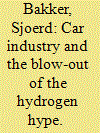

|
|
|
|
|
| Publication |
2010.
|
| Summary/Abstract |
The hydrogen hype of the last decade has passed and it is now seemingly substituted by the electric vehicle hype. A technological hype can have both positive as well as negative consequences. On the one hand it attracts sponsors for technology development but on the other hand the high expectations might result in disappointment and subsequent withdrawal of the sponsors. In this paper I ask the question to what extent the car industry has created the hype and how it has done so. The industry's role is studied through their prototyping activities and accompanying statements on market entry. I conclude that the car industry has indeed inflated the hype, especially through its public statements on market release after the turn of the millennium. Furthermore, it can be concluded that the industry has shown a double repertoire of both highly optimistic and more modest statements. It is possible that statements are used deliberately to serve the industry's interests whenever needed. Without neglecting the positive influence of technological hype on public policy and private funding for R&D efforts, more modest promises could serve the development of sustainable mobility better. For policy makers the challenge is to remain open to different options instead of following hypes and disappointments as they come and go.
|
|
|
|
|
|
|
|
|
|
|
|
|
|
|
|
| 11 |
ID:
099346


|
|
|
|
|
| Publication |
2010.
|
| Summary/Abstract |
This article examines the major factors that will shape the second phase of Caspian oil and natural gas export. The article compares the prospects of the post-2005 period with the Caspian energy developments in the first decade and a half after independence. This article claims: One, political considerations will continue to play an important role in the decisions on export routes for and participants in Caspian energy production and export projects. However, those political considerations will produce different policies in phase two of Caspian energy production than they did in the first phase. Second, the relative influence and interest in the Caspian region of various global and regional powers have changed significantly from Caspian energy phase one to phase two. Third, the producers in the region are not as anxious for foreign investment as they were earlier. The major resources that will be developed in Caspian phase two are: new production of Azerbaijan's natural gas, extension to new markets and expansion of capacity of existing gas export routes; new production projects for Turkmenistan's natural gas and new pipelines; and additional Kazakhstani oil production and natural gas increased production and initiation of export.
|
|
|
|
|
|
|
|
|
|
|
|
|
|
|
|
| 12 |
ID:
099234


|
|
|
|
|
| Publication |
2010.
|
| Summary/Abstract |
The aim of this paper is to examine the existence and direction of the causal relationship between energy consumption and output growth in the Indian cement industry for the period 1979-80 to 2004-05. The most recently developed panel unit root, a heterogeneous panel cointegration and panel-based error correction model, is applied within a multivariate framework. The empirical results confirm a positive, long-run cointegrated relationship between output and energy consumption when heterogeneous state effects are taken into account. We also found a long-run, bi-directional relationship between energy consumption and output growth in the Indian cement industry for the study period, implying that an increase in energy consumption directly affects the growth of this sector and that growth stimulates further energy consumption. These empirical findings imply that energy consumption and output are jointly determined and affect each other. The empirical evidence also suggests the implementation of energy conservation policies oriented toward improving energy-use efficiency to avoid any negative impacts of the conservation policies on the growth of this industry.
|
|
|
|
|
|
|
|
|
|
|
|
|
|
|
|
| 13 |
ID:
099218


|
|
|
|
|
| Publication |
2010.
|
| Summary/Abstract |
In 2005, the Chinese government announced an ambitious goal of reducing energy consumption per unit of gross domestic product (GDP) by 20% between 2005 and 2010. One of the key initiatives for realizing this goal is the Top-1000 Energy-Consuming Enterprises program. The energy consumption of these 1000 enterprises accounted for 33% of national and 47% of industrial energy usage in 2004. Under the Top-1000 program, 2010 energy consumption targets were determined for each enterprise. The objective of this article is to evaluate the program design and initial results, given limited information and data, to understand the possible implications of its success in terms of energy and carbon dioxide emission reductions and to recommend future program modifications based on international experience with similar target-setting agreement programs. Even though the Top-1000 program was designed and implemented rapidly, it appears that - depending upon the GDP growth rate - it could contribute to somewhere between approximately 10% and 25% of the savings required to support China's efforts to meet a 20% reduction in energy use per unit of GDP by 2010.
|
|
|
|
|
|
|
|
|
|
|
|
|
|
|
|
| 14 |
ID:
099331


|
|
|
|
|
| Publication |
2010.
|
| Summary/Abstract |
Throughout the history of the electricity industry, regulatory reform has been driven by the pursuit of tools able to create conditions that would favour infrastructure investment and, generally, to surmount the obstacles that hinder system expansion. This article addresses the interaction between regulatory schemes and electric power generation investment, with a review of the changing role of the State in the expansion of electricity supply in Latin America. It contains a critical assessment of changes in the regulatory framework since the outset of electric power market reform, describing the successive approaches to regulation adopted in the last three decades. The aim of this analysis is to help identify the key factors underlying the evolution of energy policies and to contribute to the formulation of a prospective view of the direction this evolution may reasonably be expected to take.
|
|
|
|
|
|
|
|
|
|
|
|
|
|
|
|
| 15 |
ID:
099256
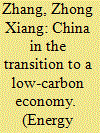

|
|
|
|
|
| Publication |
2010.
|
| Summary/Abstract |
China, from its own perspective cannot afford to and, from an international perspective, is not allowed to continue on the conventional path of encouraging economic growth at the expense of the environment. Instead, China needs to transform its economy to effectively address concern about a range of environmental problems from burning fossil fuels and steeply rising oil import and international pressure on it to exhibit greater ambition in fighting global climate change. This paper first discusses China's own efforts towards energy saving and pollutants cutting, the widespread use of renewable energy and participation in clean development mechanism, and puts carbon reductions of China's unilateral actions into perspective. Given that that transition to a low carbon economy cannot take place overnight, the paper then discusses China's policies on promoting the use of clean coal technologies and nuclear power. Based on these discussions, the paper provides some recommendations on issues related to energy conservation and pollution control, wind power, nuclear power and clean coal technologies and articulates a roadmap for China regarding its climate commitments to 2050.
|
|
|
|
|
|
|
|
|
|
|
|
|
|
|
|
| 16 |
ID:
099272


|
|
|
|
|
| Publication |
2010.
|
| Summary/Abstract |
The aim of this study was to assess the current situation of the forest bio-energy development in China. This assessment is based on opinions of Chinese academic experts. Key drivers and uncertainties regarding the implementation, and the strategies for the future practices in the development of forest bio-energy were investigated. In addition, the purpose of this study was also to determine whether there is a consensus among the experts concerning forest bio-energy and if this consensus agrees with policy-makers in China. A thorough assessment was conducted using a two-round Delphi survey of sixty-one bio-energy experts in China. The results revealed the advantages, potential problems, and the experts' recommendations for the future development. Furthermore, the experts agreed that the Chinese government plays a dominant role in the development process of forest bio-energy in the country. The experts recognized that the process of developing forest bio-energy is a challenging task both domestically and globally. At the same time they also highlighted the potential benefits of developing forest bio-energy in China during the next ten years. The outcomes of this study could be used to give advice to policy-makers and to support the implementation of the future forest bio-energy policies in China.
|
|
|
|
|
|
|
|
|
|
|
|
|
|
|
|
| 17 |
ID:
099216


|
|
|
|
|
| Publication |
2010.
|
| Summary/Abstract |
China is the largest nonferrous metals producer in the world and largest consumer for six kinds of common nonferrous metals including copper, aluminum, zinc, lead, nickel and tin. This paper provides an overview of the nonferrous metals industry in China, from a CO2 emissions reduction perspective. It addresses energy use disaggregated by energy carrier and by province. It focuses on an analysis of energy efficiency in the production of aluminum, copper and nickel. A few large-scale enterprises produce most of the aluminum, copper and nickel in China, and use manufacturing facilities that were built within the last 20 years or have recently upgraded their main production equipment and processes. The energy efficiency of these operations is not particularly low compared to international practice. A large number of small and medium-sized enterprises (SME) operate nonferrous metals production facilities which rank low in energy efficiency and therefore are highly energy intensive per unit of physical output. Backward production capacity would be phased out continuously by enforcing the energy intensity norms.
|
|
|
|
|
|
|
|
|
|
|
|
|
|
|
|
| 18 |
ID:
099363
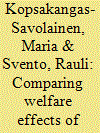

|
|
|
|
|
| Publication |
2010.
|
| Summary/Abstract |
We compare the welfare effects of different regulation schemes of electricity distribution utilities. The compared regulation schemes are Fixed Price regulation, Cost of Service regulation, Menu of Cost-Contingent Contracts and Simple Menu of Contracts. In our calculations we utilize the information of a firm's potential to improve cost efficiency. The firm-specific cost information of Finnish electricity distribution utilities is obtained by using various Stochastic Frontier models. Our basic result is that welfare can be improved by changing the Cost of Service regulation scheme to the Menu of Contracts regulation. Welfare also increases in the case of Fixed Price regulation and Simple Menu of Contract regulation. There is however, a significant difference among regulation regimes on how this improved welfare is distributed to consumers and producers.
|
|
|
|
|
|
|
|
|
|
|
|
|
|
|
|
| 19 |
ID:
099329


|
|
|
|
|
| Publication |
2010.
|
| Summary/Abstract |
New electrified vehicle concepts are about to enter the market in Europe. The expected gains in environmental performance for these new vehicle types are associated with higher technology costs. In parallel, the fuel efficiency of internal combustion engine vehicles and hybrids is continuously improved, which in turn advances their environmental performance but also leads to additional technology costs versus today's vehicles. The present study compares the well-to-wheel CO2 emissions, costs and CO2 abatement costs of generic European cars, including a gasoline vehicle, diesel vehicle, gasoline hybrid, diesel hybrid, plug in hybrid and battery electric vehicle. The predictive comparison is done for the snapshots 2010, 2020 and 2030 under a new energy policy scenario for Europe. The results of the study show clearly that the electrification of vehicles offer significant possibilities to reduce specific CO2 emissions in road transport, when supported by adequate policies to decarbonise the electricity generation. Additional technology costs for electrified vehicle types are an issue in the beginning, but can go down to enable payback periods of less than 5 years and very competitive CO2 abatement costs, provided that market barriers can be overcome through targeted policy support that mainly addresses their initial cost penalty.
|
|
|
|
|
|
|
|
|
|
|
|
|
|
|
|
| 20 |
ID:
099266


|
|
|
|
|
| Publication |
2010.
|
| Summary/Abstract |
Plug-in hybrid electric vehicles (PHEVs) have been promoted as a potential technology that can reduce vehicles' fuel consumption, decreasing transportation-related emissions and dependence on imported oil. The net emission and cost impacts of PHEV use are intimately connected with the electricity generator mix used for PHEV charging, which will in turn depend on when during the day PHEVs are recharged. This paper analyzes the effects of a PHEV fleet in the state of Ohio. The analysis considers two different charging scenarios-a controlled and an uncontrolled scenario-which offer the grid operator different levels of control over the timing of PHEV charging. The analysis shows that PHEV use could result in major reductions in gasoline consumption of close to 70% per vehicle compared to a conventional vehicle (CV) under both charging scenarios. Moreover, despite the high penetrations of coal in the Ohio power system, net CO2 emissions from a PHEV could be up to 24% lower than that of a CV in the uncontrolled case, however, CO2 and NOx emissions would increase in both scenarios.
|
|
|
|
|
|
|
|
|
|
|
|
|
|
|
|
|
|
|
|
|